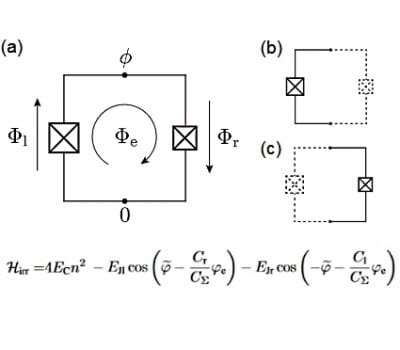In a collaboration with the Houck Lab, we use the quasienergy structure that emerges when a fluxonium superconducting circuit is driven periodically to encode quantum information with dynamically induced flux-insensitive sweet spots. The framework of Floquet theory provides an intuitive description of these high-coherence working points located away from the half-flux symmetry point of the […]
Author: Brian
New arxiv preprint: Positive- and negative-frequency noise from an ensemble of two-level fluctuators
The analysis of charge noise based on the Bloch-Redfield treatment of an ensemble of dissipative two-level fluctuators generally results in a violation of the fluctuation-dissipation theorem. The standard Markov approximation can be identified as the main origin of this failure. The resulting decoherence rates only involve the bath response at the fluctuator frequency, and thus […]
New arxiv preprint: Engineering Dynamical Sweet Spots to Protect Qubits from 1/f Noise
Protecting superconducting qubits from low-frequency noise is essential for advancing superconducting quantum computation. We here introduce a protocol for engineering dynamical sweet spots which reduce the susceptibility of a qubit to low-frequency noise. Based on the application of periodic drives, the location of the dynamical sweet spots can be obtained analytically in the framework of […]
Protecting a bosonic qubit with autonomous quantum error correction
To build a universal quantum computer from fragile physical qubits, effective implementation of quantum error correction (QEC) is an essential requirement and a central challenge. Existing demonstrations of QEC are based on a schedule of discrete error syndrome measurements and adaptive recovery operations. These active routines are hardware intensive, prone to introducing and propagating errors, […]
New arXiv preprint: Universal fast flux control of a coherent, low-frequency qubit
The heavy-fluxonium circuit is a promising building block for superconducting quantum processors due to its long relaxation and dephasing time at the half-flux frustration point. However, the suppressed charge matrix elements and low transition frequency have made it challenging to perform fast single-qubit gates using standard protocols. We report on new protocols for reset, fast […]
Optimal control utilized to tackle challenge of performing gates on protected qubits in new PRA paper
In a new PRA paper, quantum optimal control theory is employed to realize quantum gates for two protected superconducting circuits: the heavy-fluxonium qubit and the 0-π qubit. Utilizing automatic differentiation facilitates the simultaneous inclusion of multiple optimization targets, allowing one to obtain high-fidelity gates with realistic pulse shapes. For both qubits, disjoint support of low-lying […]
New editor suggested PRB publication: Spectrum and coherence properties of the current-mirror qubit
Superconducting qubits designed to exhibit protection from noise have recently received attention in the search for a qubit with coherence times that could exceed those of current state-of-the-art qubits. The current-mirror circuit has long been proposed as such a protected qubit. Based on an effective model capturing the low-energy excitations of the circuit, we present […]
Recent Nature Physics paper published: Quantum control of an oscillator using a stimulated Josephson nonlinearity
Superconducting circuits extensively rely on the Josephson junction as a nonlinear electronic element for manipulating quantum information and mediating photon interactions. Despite continuing efforts in pushing the coherence of Josephson circuits, the best photon lifetimes have been demonstrated in microwave cavities. Nevertheless, architectures based on quantum memories require a qubit element for logical operations at […]
New arxiv preprint: Experimental realization of an intrinsically error-protected superconducting qubit
Encoding a qubit in logical quantum states with wavefunctions characterized by disjoint support and robust energies can offer simultaneous protection against relaxation and pure dephasing. Using a circuit-quantum-electrodynamics architecture, we experimentally realize a superconducting 0−π qubit, which hosts protected states suitable for quantum-information processing. Multi-tone spectroscopy measurements reveal the energy level structure of the system, […]
New PRB paper: Circuit quantization in the presence of time-dependent external flux
Circuit quantization links a physical circuit to its corresponding quantum Hamiltonian. The standard quantization procedure generally assumes any external magnetic flux to be static. Time dependence naturally arises, however, when flux is modulated or when flux noise is considered. In this case, application of the existing quantization procedure can lead to inconsistencies. To resolve these, […]







